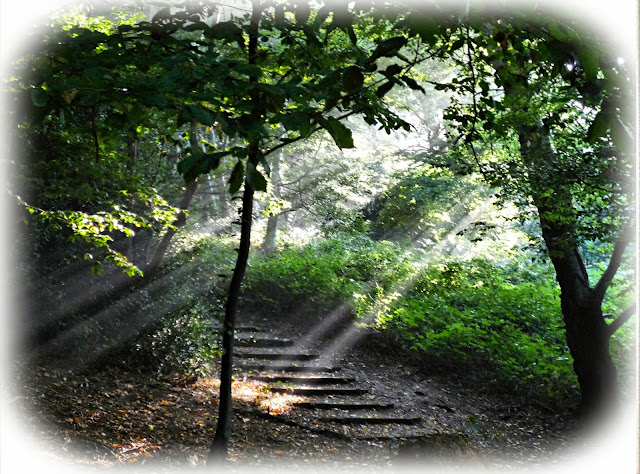Ashenbank is a lovely ancient woodland, originally part of Cobham Hall estate, which you can view from the car park across Halfpence lane, now owned and managed by the Woodland Trust.
I have been walking these woods for many years now with my dog on a daily basis.
You certainly get a feel of the changing seasons as the year moves on.
Its at this time of the year, early autumn, when the deadwood habitat comes into its own and various fungi begins to appear.
As the last rays of sunshine permeate the ancient trees, the early morning mists create a mystical feel to the woods.
Because of the large amount of decaying wood found both on the trees and lying on the woodland floor.
Ashenbank is an important site for Fungi.
A survey back in 1999 recorded over 238 species, ten of which are considered very rare.
As you walk around the woods there is much evidence of the damage caused by the Great storm of 1987. All now providing that important deadwood habitat.
The woodland trust say that some of the tree's here quite ancient, some ranging from 200 to 350 years.
That means that some of these trees were beginning there life during the reign of King Charles II.

I have often wondered what the reason was for securing these old timbers to standing mature trees.
The route of the channel tunnel rail link cut off the northeast corner of the wood, and as part of the mitigation to compensate for the habitat loss, some of the felled trees were re-erected to recreate large diameter standing decaying wood. A total of twelve stems of mixed species,age and dimensions were strapped to the mature trees using steel cables
On the boundary of Ashenbank Woods and Jeskyns Park, its amazing to see how many spiders occupy the grassland.
The early morning mist highlighting their webs.
These are some of the fungi that have caught my eye over the last few days
Chicken of the woods is only found on trees, living or dead. Apparently most commonly found on oak,cherry wood, sweet chestnut and willow, it is edible if cooked.
But more worrying if found growing on yew or cedar, it is poisonous.
This fungi called chicken of the woods because its firm, pale and fibrous but tender, like a chicken breast, for that reason it makes an excellent meat substitute for vegetarians, when cooked has a truffle aroma and flavor, although my wife is not convinced, or ready to try it yet.
Beefsteak fungus or ox tongue, is another bracket type fungus found usually on oaks or sweet chestnut, again on living or dead trees. Has been used as a meat substitute in past times, it has a sour slightly acidic taste,
has to be picked when young, and because it is tough needs to be cooked for a long time, doesn't sound very appetizing
'Many layered Polypore' inedible, but an important fungus for decaying wood.
Dead mans fingers generally considered not to be edible, really!
another quite common fungi usually found on beech wood stumps or buried hardwood.
Most Puffball fungi are apparently safe to eat. you are supposed to check by slicing in half, they must be all white on the inside and of a uniform consistency any yellow or purple makes them inedible.
The recipe below makes them sound delicious, might give this a try.
[Some people refer to puffballs as "breakfast mushrooms" because they blend so well with eggs. But they also serve beautifully as side dishes with dinner entrees. A thick slab of puffball develops a lovely golden color when browned in butter. They are often cut into cubes for cooking.
Dip slices in a batter of egg and milk and cover with bread crumbs seasoned with salt and pepper. Sauté in butter and serve with a piquant sauce as the main course for a vegetarian dinner.]
'Stinkhorn'
Believe it or not, inedible, supposed to give off an unpleasant odor.
This one stood firm for three days before collapsing into a slimy
mess, but I still couldn't detect any unpleasant odors.
Not sure what these are called.
Each new day at the moment seems to reveal a new type of fungi. Lots of photo opportunities.
My favorite tree of the wood
The woodland trust have introduced some highland cattle to the wood, five in fact, these cattle have been in residence for most of the summer and are soon to leave, I think the idea was to allow the cattle to naturally eat there way through the undergrowth and encourage woodland pasture areas.
Now these cattle do look quite intimidating when they are blocking the pathways.
I have been telling my wife to walk through them ,
' show no fear '
A few weeks ago, while walking the dog, one of the young heifers scuppered my theory, while one of the larger cows was checking out my dog, who was doing his best, pretending to be a tree, a young heifer crept up behind me and gave me a bit of a butt.
no damage done,only my pride.
"The Beast"
Doesn't look so scary now though ,
is she trying to tell me something !!






















No comments:
Post a Comment